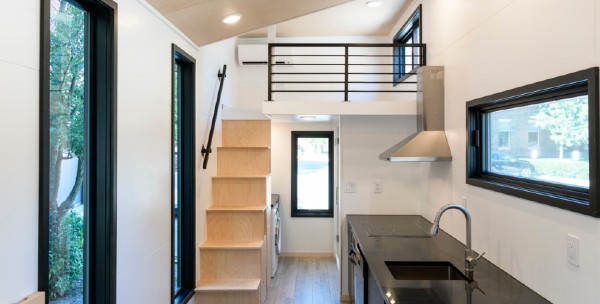Tiny House, Giant Impact
Compact research space gives students zEDGE to evaluate a zero-energy structure
At just 192 square feet, Purdue University's newest civil engineering laboratory is remarkably small for a research space. Yet, Lyles School of Civil Engineering Visiting Purdue Professor Nusrat Jung has big plans for it.
The architectural engineering laboratory comes in the form of a tiny house, called zEDGE (zero-Energy Design Guidance for Engineers), that Jung and a team of students designed and engineered for testing the energy efficiency of large structures on a small scale. Built on a trailer for easy mobility, zEDGE is stationed outside Hampton Hall.
"It's very small but it's a powerhouse," Jung said. "zEDGE is a great research lab for our students, because it's something very compact that still has all the energy efficiency parameters of a larger building, something very real that they can evaluate in real life."
Netting zero
Increased energy efficiency and small homes are not new concepts, and the two have been closely tied since the small house movement emerged in the 1980s. The movement calls for a return to houses of less than 1,000 square feet, with tiny houses typically defined as those that measure less than 400 square feet. By comparison, the average size of a single-family home in America has grown to more than 2,600 square feet.
What makes the zEDGE project innovative is its mission: learning how to evaluate components of a truly zero-energy structure, which is the ultimate goal of many small-house and sustainability advocates. A net zero-energy building has zero net energy consumption over a 12-month period, meaning the amount of energy it uses in a year equals the amount of renewable energy created on the site.
"Energy efficiency and sustainability are things that have always resonated with engineers," Jung said. "Now, more and more people are realizing how important it is. What I found out is that there is a lot of interest in zero-energy buildings, which is my area of expertise, but not much knowledge of how to evaluate one."
Fun with fundamentals
Jung recruited four students to join her design and engineering team, including civil engineering graduate students Motasem Qadan, Aditya Shivaji Mane and Chengbo Du — as well as undergraduate student Reno Lewis Sarussi. The four worked on every aspect of the design, from modeling and materials to energy-use calculations and the electrical and plumbing systems — all with an eye on innovation, efficiency and sustainability.
The final design featured many new energy technologies and components, including cutting-edge measuring instrumentation, high-efficiency lighting, two types high-efficiency insulation and unique Zip System sheathing that created a totally enclosed "building envelope." The house also has a solar energy system, pitched at the ideal angle for energy collection, and a water-collection system.
"The fact is that, with a tiny house, you can get away with some things that would take much more effort with a regular house — things like changing the direction of the house to reach the maximum solar energy potential. It is also easier to evaluate all the systems," said Qadan. "But you have to give a lot of attention to detail on a house on wheels, one that could be driving down the highway at 80 miles per hour. Nothing was done at random."
Finding the right builder for the project was one of the team's toughest challenges, Jung said. After an extensive search, they partnered with Colorado-based MitchCraft Tiny Homes. Construction began last December, and the final product was delivered to Purdue's campus in August.
MitchCraft owner Mitch Holmes, whose company has been building tiny homes since 2015, found the project both challenging and rewarding.
"Each home we build is a completely unique project with its own set of processes and challenges, so the Purdue project was no different in that regard," Holmes said. "But having Purdue engineers design the entire house, and having to build to such detailed specs, was definitely something new. It's certainly a nice project to add to our repertoire."
Eye on the future
In many ways, Jung sees both herself and zEDGE as part of a changing civil engineering landscape. Not only is she taking the lead as her field addresses the world's emerging sustainability issues, she is a female professor in a traditionally male-dominated area.
"Stereotypes exist, of course, but I think the gender dynamic is changing," Jung says. "One thing I really believe is that knowledge does not have a gender. I suppose I'm an example for young people of all genders that you can do amazing things if you simply have a passion. I think you can make your own story."
Jung recently received a Protect Purdue Innovations Faculty Grant and will carry out a research project in zEDGE to evaluate the chemical risk assessment of COVID-19 disinfection activities in buildings.

